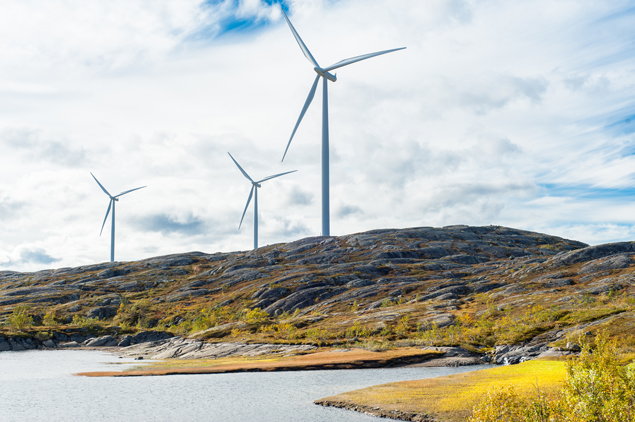
But to achieve this Europe must be able to offer all the advantages of its single market by enabling investors to profit from extensive large demand. Even without the US president’s decision, building a single energy market is in the interests of European consumers for the simple reason they stand to benefit from economies of scale. What is more, the energy transition the Paris Agreement calls for would then take place at the lowest price possible.
The US withdrawal represents a unique opportunity for the EU to attract investors, entrepreneurs and international scientists to this priority sector, making Europe the leader of the transatlantic world in the energy transition. Such a historic occasion has not arisen in any field of technology since the end of the Second World War. Indeed, Europe has the chance to be seen as the continent paving the way to the future, attracting capital and talent from across the globe in green energy technology. It is an opportunity not to be passed up.
The EU has so far failed to take full advantage of its single market to kickstart a veritable transformation of its productive capacities and become a leader in clean technologies. For example, while European manufacturers are rallying to defend combustion engines – including diesel – India has announced that all new vehicles sold within its borders will be electric by 2030. On top of this, whereas European car makers lead China’s market in vehicles with combustion engines, Chinese auto companies are the best when it comes to electric vehicles. On the other side of the Atlantic, US companies are inventing the autonomous and electric automobile, with Tesla, Google, Uber and others investing massively in new technologies. South Korea and Japan, for their part, have the largest battery production capacity and the best technologies in the field.
At this rate, Europe will miss the boat for the auto industry revolution. Indeed, despite the EU’s success in wind farms and, initially, in photovoltaic panels, which benefitted from generous subsidies, it has had difficulty in using the size of its single market to make inroads in new industries. The reason for this is not a dearth of innovative companies but rather a fragmented market with diverse national regulations, which stymies development on an EU level. Contrary to American companies and the US market, European firms haven’t been able to use the large single market as a springboard for international markets.
It is not too late to take action. Two things must be done: develop a policy to set a path for a carbon price coherent with the goal of reducing emissions across the economy and complete the single market to unleash corporate growth and the development of new technologies on a European level.
Advantages but still too many shortcomings
Europe’s collective action in the international climate negotiations, which culminated in the Paris Agreement, was an instance of real leadership. This was made possible by ambitious European climate objectives and the fact that those set for 2020 had already been met.
The EU’s Emissions Trading System (ETS) is a unique initiative in the international arena to harmonise the carbon price. Even though it has yet to prove fully effective, the fact it was created is an important step in itself.
At about €5 per tonne, the price in the ETS is well below the level needed to see through the energy transition in manufacturing and the production of electricity. This is largely the result of certain countries opposing action to raise the carbon price so as to avoid penalising the coal industry (Germany, for example, gets more than 40 per cent of its electricity from coal). Moreover, the EU has failed to implement a common policy for the carbon price in sectors not covered by the ETS, such as transport, residential/services and agriculture, which together represent 70 per cent of the emissions of a country like France.
Europe’s objectives for reducing emissions by 2030 and beyond must be substantially increased if they are to be consistent with the goal of keeping the planet’s warming within 2°C. In fact, even without taking into account the US’ decision to exit the agreement, stabilising the climate as stipulated by the Paris Agreement will require an overall effort of an extra 30 per cent reduction in emissions. This means reaching carbon neutrality in developed countries by 2050 and then extending this across the globe in the second half of the twenty-first century. [1]
Complicating this is the fact Europe’s electricity market is in shambles. Regardless of the energy source, no investment in production has been profitable in the market conditions of the past few years. The power companies are suffering great financial difficulty, while consumers have not benefitted from the reduction in prices market liberalization was supposed to bring. The integration of national markets has largely stalled.[2]
Lastly, as mentioned above for the auto industry, different national regulations prevent young innovative companies from developing on a European level. This has particularly dire consequences when it comes to energy and green technologies, with only the largest companies able to deal with the diverse regulations. For small and medium-sized enterprises (SMEs), the complexity of diverse national regulations represents a direct cost to doing business in different countries. One possible solution is move towards harmonising European commercial law, as proposed by a group of Franco-German legal experts.[3] Alternatively, the regulatory barriers can be reduced by systematically evaluating their costs and benefits on a European level while gradually adopting better practices.[4]
Energy in Europe and the energy transition: four key areas to be addressed
Establish a uniform strategy for the price of carbon on a European level in line with the goal of zero net emissions by 2050
- A European authority for the ETS should be created to improve its effectiveness. Its mission would be to ensure the carbon price stays within a certain range that is consistent with the goal of zero net emissions by 2050. In the meantime, Europeans need to agree on a path for an indicative carbon price following the work of the High Level Commission for Carbon Price chaired by Nicholas Stern and Joseph Stiglitz.[5] This would serve to guide companies, who already have their own carbon prices for their investment decisions. It would also be a reference for cost-benefit analyses carried out for investments in the public sector.
- A uniform European carbon tax should be introduced for the sectors not covered by the ETS, with a trajectory in line with the 2050 goal. This tax could replace other taxes that penalise production or consumption to ensure the overall amount levied remain the same. Recent research by Harvard economist Martin Weitzman suggests if European Council members voted in majority on the amount of the carbon price, the level of the carbon tax they would decide on would be close to the efficient level. This is due simply to the homogeneity of members’ energy preferences and cost structures.
- This tax could be implemented in such a way so as to limit the negative impact on sectors exposed to international competition. More specifically, the taxes levied on a sector’s companies could be paid back to them based on their market share. For example, shipping companies might have to pay a fuel tax, which could be then paid back to them according to a coefficient for tonnes transported per kilometre. This would still incite companies to use cleaner ships, without increasing the average tax pressure for the sectors’ companies. A similar measure could be implemented for aviation. Foreign companies would also receive their share of taxes collected in the sector, thus mollifying international opposition.
- The EU could aim to build a club of countries committed to an emissions reduction goal, without necessarily hindering the implementation of a European carbon tax. Member countries could, for example, benefit from preferential tariffs, laying the basis for a “climate club” as William Nordhaus has proposed.[6]
Make full use of the Single Market’s potential
- Create a sole regulatory body for the EU or a network of regulators much more integrated like the national and European competition authorities. This is a priority when it comes to the energy sector (there could still well be different national mixes of energy sources used). It should also be a priority for the digital economy, which has an impact on the entire economy, including industries that are crucial for the energy transition.
- Jointly define the challenges and opportunities for the centre-west Europe electricity region by 2040. Despite substantially different mixes of energy sources, the hub’s countries face the same challenges over the next two or three decades. They should carry out an assessment and identify the challenges that might be overcome by increased cooperation, reinforcing the Pentalateral Energy Forum’s role of coordinating and exchanging information. While the approaches taken by the hub’s countries can be perfected, the objectives are at hand. There needs to be a common understanding and a common move towards the goal of coordinated mechanisms, for example, when it comes to managing production capacity.
- Europe should make better use of norms and standards to foster innovation and propel the energy transition forward. For instance, the EU should adopt a regulation requiring all auto makers – European and foreign alike – to sell only zero-emissions vehicles (ZEVs) in the single market by 2035. By setting such an ambitious long-term standard, the 27 member states would greatly reduce uncertainty for manufacturers and encourage them to concentrate their investments on clean vehicles. Developing the same approach in other sectors would be a powerful incentive for companies to increase their investments in innovation. With respect to smart networks and electricity storage, for example, the EU must prevent competing standards from being developed, as has happened for electric vehicles. It needs to foster cooperation to develop a common European approach.
- A techno-economic analysis should be carried out to determine how investment costs are shared to reinforce the interconnection of national power grids. In the past, when power lines were built to connect two areas with different prices, the economic calculus was relatively simple and dividing the rent easy. Today, the gains are dissymmetric and have more to do with security of supply than exchanging kilowatt hours. The sharing of the investment costs should take a better account of the benefits.
- Have a truly common foreign policy on energy. The EU has to draw on the size of its domestic market to negotiate from a position of strength agreements on supply from foreign countries, better fight against monopolistic practices from companies like Gazprom and develop the production of renewables abroad to supply Europe with energy. This requires a real sharing of sovereignty to go beyond narrow national interests and basic declarations of intent. [7]
Develop innovative financing
- Another crucial area that needs to be addressed is venture capital funds. Though Europe has abundant savings, it does not invest enough in financing projects with high potential growth, such as startups in the energy transition. Whereas the US invests €65 billion in venture capital each year and China more than €30 billion, Europe as a whole invests less than €13 billion. There must be a concerted effort to collectively structure and substantially expand Europe’s venture capital industry.[8]
- The financial sector has to be better mobilised to finance the investments necessary for the energy transition. The European Investment Bank (EIB) estimates the annual investments necessary for the energy sector alone in Europe amount to €230 billion per year, some €100 billion more than current levels. An additional €80 billion is needed to finance the infrastructure necessary for clean vehicles.[9] Green bonds and carbon certificates, which some member states have experimented with, need to be developed in a coordinated and voluntary manner on a European level.[10]
- The quantitative easing policy of the European Central Bank (ECB) will no doubt end in 2018. It is conceivable that after this date the ECB purchase green bonds with a maturity of 100 years at 1 per cent. The aim would be to undertake energy renovation projects, for example, which would have a small return in the immediate future, but as the price of carbon increases, their profitability would go up. Financial institutions would issue these green bonds, and they would finance investments from both individuals and companies over the same time horizon.
Increase the support to R&D in this sector across Europe
- The EU could also issue green bonds with the same maturity and at the same 1 per cent rate to finance research programmes in the field for all private and public institutions present in Europe. They could also finance visits from foreign researchers.
- Electric motorways are an example of an area of innovation that can be looked into. Certain stretches could be equipped to allow hybrid lorries to reduce their emissions or to switch back to fuel depending on power consumption in the country. This project, which is already developed experimentally in California, could be collectively explored to assess its viability, with a view to experimenting it on key motorways.
- Another obvious and important avenue for carbon reduction where innovation has a key role to play is to be found in the development of autonomous vehicles. Here, the EU must put in place a common regulatory framework to allow for the rapid introduction and diffusion of autonomous vehicle technology at the scale of the continent.[11]
The member states should decide collectively of a common strategy to end coal production of electricity. This should be accompanied by specific European programmes for retraining of people and regeneration of territories when adversely affected. However, if it proves too difficult to remedy the ETS in the short term and expand the carbon price mechanisms to cover other sectors, the recommendations regarding the domestic market could in part fill in the gap. In effect, these initiatives can become reality if Europeans agree to undertake an ambitious policy with respect to the carbon price.
Vincent Aussilloux is head of the economics department, France Stratégie. Alain Trannoy is a scientific adviser, France Stratégie and director, Aix-Marseille School of Economics. The views expressed in this essay are those of the authors and do not necessarily represent the views of their organisations.
[1] France Stratégie 2017-2027 climate note.
[2] Poland and the Czech Republic demanded phase-shift transformers be installed at their borders to cut off the current endangering their networks.
[3] Association Henri Capitant (2016), “La construction européenne en droit des affaires : acquis et perspective”, (“Building Europe through commercial law: progress and perspectives”).
[4] Aussilloux et al (2017), “Tirer le meilleur du marché unique européen” (“Getting the best out of the European single market”), CAE note No. 38; Aussilloux (2017), “De meilleures réglementations pour un marché unique européen plus intégré” (“Better regulations for a more integrated European market”), forthcoming.
[5] Report of the High Level Commission on Carbon Prices, May 29, 2017.
[6] Nordhaus, William D. (2015), “Climate Clubs: Designing a Mechanism to Overcome Free-riding in International Climate Policy”, American Economic Review 105 (4).
[7] Dominique Auverlot, Etienne Beeker, Gaëlle Hossie (2015) : Pour la création d’une véritable Europe de l’énergie, France Stratégie.
[8] See “Mobiliser l’épargne pour le financement des startups”, France Stratégie, Critical Actions 2017-2027.
[9] European Investment Bank (2016), Restoring EU competitiveness.
[10] EPSC (2017), Financing Sustainability – Triggering Investments for the Clean Economy.
[11] For impact of autonomous vehicles on emissions and recommandations for EU actions in this field, see Ranft, Adler, Diamond, Guerrero, Laza (2016): Freeing the Road – Shaping the future for autonomous vehicles, Policy Network Special Report.







